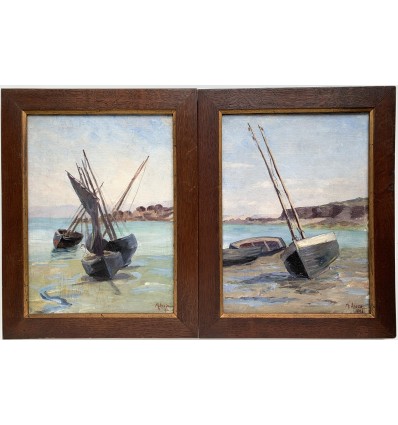International Shipping Secure Payment
No products
Product successfully added to your shopping cart
There are 0 items in your cart. There is 1 item in your cart.
Marguerite AROSA (1854-1903)
New
Pair of seascapes
Signed oil on canvas
Already Sold
Marguerite AROSA (1854-1903)
Pair of seascapes
Oil on canvas signed lower right and dated 1898
Original frames
Format (canvas): 33 x 24 cm
Format (frame): 40 x 31 cm
French painter and watercolourist from a Parisian upper middle-class family. His father, Gustave Arosa, had a vast collection of contemporary art, including paintings by Delacroix, Corot, Courbet, Daubigny, painters of the Barbizon school, but also ceramics. On the death of Paul Gauguin's mother in 1867, Gustave Arosa became her children's guardian. In Arosa's house in Paris and in his country house in Saint-Cloud, the young Gauguin became acquainted with this art. Gauguin joined the French navy the following year and returned to Paris in 1871 to take up a position as a stockbroker with Paul Bertin, probably organised by Arosa. Around Christmas 1872, Gauguin met his future wife, the Dane Mette-Sophie Gad, at Arosa's in Paris. Marguerite Arosa is well known for her landscapes, seascapes and portraits. A pupil of Mayer, Félix-Joseph Barrias (1822-1907) and the realist painter Armand Gautier (1825-1894), she passed on her enthusiasm for art to Gauguin, who produced his first paintings with her. She taught him the technique of oil painting and they regularly went to paint together on Sundays on the outskirts of Paris.
Charming and full of character, Marguerite Arosa did not take part in the Impressionist and Post-Impressionist movements, and no substantial trace of a lasting friendship between her and Gauguin has been found. As a result, her career has gone virtually unnoticed, except in Spain, where she is considered - wrongly - as a Spanish artist; so much so, in fact, that she has even been included in the recently published dictionary of national biography. Marguerite has exhibited in Spain on a number of occasions, including three times at the Exposición Nacional de Bellas Artes in Madrid, where she twice received honourable mentions from the jury. On the whole, however, her presence in Spain is nothing in comparison with her record of exhibitions in France, where she exhibited almost every year from 1881 to 1902 at the Salons of Paris, Lyon, Dijon, Rouen, Le Havre... and in countless exhibitions throughout the country, at one point even rivaling Louise Abbéma in terms of the number of distinctions received. Marguerite began ambitiously in the 1880s by exhibiting a series of nudes, but she concentrated on landscapes and seascapes around 1890. In that year she exhibited for the first time at the Salon des Femmes and became an active member of the Union of Women Painters and Sculptors, for which she assumed the responsibility of secretary around 1896. Her true place was among the generation of women artists in France who were fighting for greater professional recognition for themselves and equal access to the establishment of Fine Arts for women.



